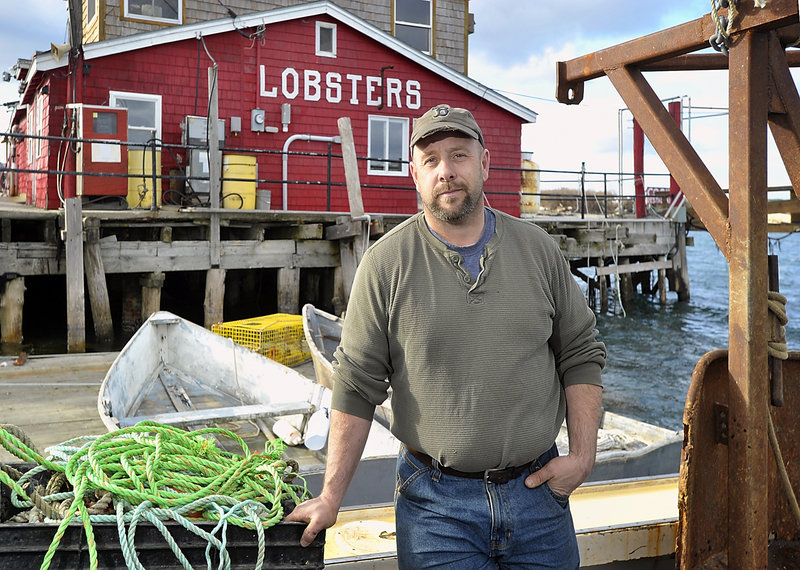With last year’s glut of lobsters and plummeting prices still a vivid memory, Maine lobstermen are hatching strategies to cultivate new markets and more customers for the state’s leading fishery.
Lobstermen expect another big harvest this year, but it’s unclear whether it will begin early again, said Marianne La-Croix, acting director of the Maine Lobster Promotion Council, an industry-funded organization in Portland.
“Obviously,” she said, “we don’t want to be in the same situation” as last year, when the lobster harvest soared but prices for fishermen took a dive to their lowest point since the mid-1990s.
In 2012, the season for shedders – soft-shell lobsters – started four to five weeks early. That brought Maine and other U.S. fisheries into competition with Canada in late May and June, said Rick Wahle, research associate professor in the School of Marine Sciences at the University of Maine.
Wahle said processors customarily handle the lobster harvest from Canadian waters, which occurs in the winter, well into May. When Maine’s lobster season started more than a month early, there weren’t enough buyers.
“The so-called glut brought the price down,” Wahle said.
Even though the timing of the harvest didn’t jibe completely with the processing demand, LaCroix said, all of the Maine lobster was marketed. “Not at the price everyone’s happy with,” she acknowledged, but it still was sold.
Within the next month, the Lobster Promotion Council and other lobstermen’s organizations will begin mapping out specific plans to expand markets and broaden their customer base.
“With a little more preparation … building a little bit of demand … more processors will be on line earlier this year,” LaCroix said.
The organization hopes to generate media attention to help consumers better understand pricing and accentuate the long history of the fishery, and the partnership between lobstermen and government.
One plan, initiated by lobstermen, is a charity event in the New York-New Jersey area, for which Maine fishermen will donate lobsters for the survivors of Superstorm Sandy. The event will be a much-needed boost to that region, and potentially will open a new market, LaCroix said.
One Portland company, Calendar Islands Maine Lobster, is working to move beyond the wholesale market by introducing new retail products.
The company, a fishermen’s cooperative that started as a wholesale operation and now sells mostly into retail channels, handles everything “from boat to end sale,” said its president, John Jordan.
He said the only realistic solution is to create demand for Maine lobsters in a different form. His company, for example, is introducing products including shelled lobster tails on cedar planks, to be grilled.
The products join a line of prepared lobster foods, including quiches, rangoons, split tails and “naked lobster” – all the meat but no shell.
“We’ve got to take Maine on the road,” Jordan said. “Maine has a fantastic identity in the food world.”
He said the high volume of lobster dictates a transition to a global market.
If prices stay in decline, lobstermen really have only two choices, said Wahle, the UMaine researcher: They can stop fishing or fish harder.
Some lobstermen already are reporting making as many as three hauls a day — early morning, midday and evening — to make up for lower prices.
Concern over the potential for a repeat of last year’s high-volume early season have arisen in part because 2012 — which brought a record harvest — turned traumatic for fishermen.
Also, there are signs that the same conditions are lining up already for 2013: early shedders, warmer water and the spread of shell disease northward from southern New England. That bacterial infection has decimated lobster populations, particularly in Rhode Island.
It’s too early to know for sure whether the soft-shell lobsters that have been sighted in the Gulf of Maine are part of a normal cycle in which a small percentage of the population molts early, according to marine scientists and shellfish monitors.
“We did get some shedders, just a few,” said Alex Todd, a fisherman from Chebeague Island, about his recent trips. “That’s not that uncommon in the last three or four years,”
Ordinarily, soft-shell lobsters come in the greatest numbers in early summer, with the big take in July, said Wahle.
Soft-shells in the winter and an early start of the lobstering season don’t necessarily mean rough waters ahead. Instead, it’s the combination of factors — more lobsters, fewer predators like cod and flounder, warming waters because of climate change — that stirs up the worries about money and secure livelihoods.
The average price of $2.69 per pound for 2012 was Maine’s lowest on record since 1994, according to Department of Marine Resources reports.
By comparison, 2011 landings were 20 million pounds less at nearly 105 million pounds. The value of that smaller catch was $3.19 a pound and close to $335 million — shy of the 2012 value, but not by much.
“The tale will really be told in April and May” when water temperature increases or fluctuations might be more evident, Jordan said.
Though there is clear evidence of warmer water and accompanying early moltings, the full picture won’t be clear for a couple of months.
But Todd said signs of a repeat of 2012 conditions in the Gulf of Maine raise anxiety about whether things are shaping up for a “perfect storm for a big lobster volume.”
North Cairn can be contacted at 791-6325 or at:
ncairn@pressherald.com
Send questions/comments to the editors.


